《乘风破浪者 自强不息人 从庄培森的书画中体会庄而逍遥的对立统一辩证关系》
- 2020-09-17 14:45:19
- 点赞量:6001
- 点击量:139446
- 作者:郝连成 Hao Liancheng
乘风破浪者,自强不息人——从庄培森的书画中体会庄而逍遥的对立统一辩证关系。
He who rides the wind and waves is a man who constantly strives for self-improvement. From Zhuang Peisen's calligraphy and painting style, he can experience the dialectical relationship of unity of opposites between Zhuang and Xiaoyao.
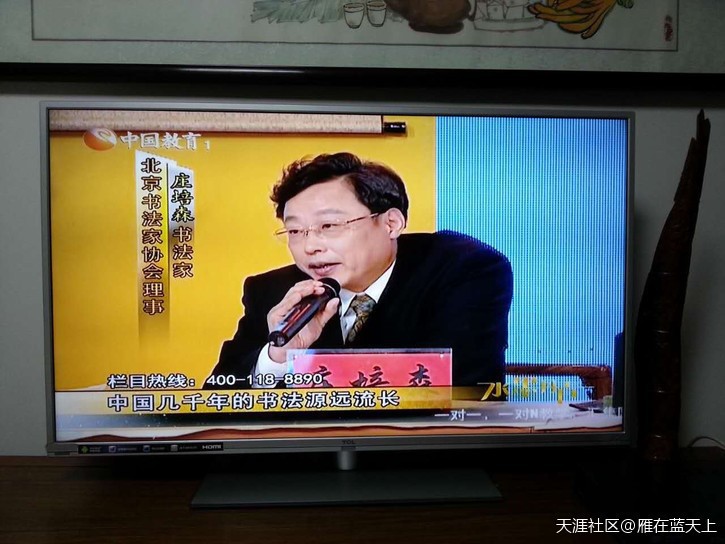
▲庄培森做客中央电视台
Zhuang Peisen visits CCTV
有幸得到一幅书法名家庄培森的现场书作:庄而逍遥,自然为美。并聆听了庄先生对“庄而逍遥自然为美”的含义解读。临别又蒙庄先生惠赠了他刚出版的由启功先生题名的《培森书画》。
Fortunately, I got a live work by Zhuang Peisen, a famous calligrapher: Zhuang and carefree, nature is beauty. And listen to Mr. Zhuang's interpretation of the meaning of "Zhuang and carefree, natural beauty". After parting, Mr. Meng Zhuang presented his newly published "Peisen calligraphy and painting" titled by Mr. Qigong.

题目中“乘风破浪“和“自强不息”是著名诗人、书法家萧劳先生和著名书画家、中央美院前教授白雪石先生为《培森书画》的题辞。回来后细细品玩,才领略到了庄培森“庄而逍遥自然为美”理念的博大精深。
In the title, "riding the wind and waves" and "constantly striving for self-improvement" are the inscriptions of the famous poet and calligrapher, Mr. Bai Xueshi, a famous calligrapher and painter, and former professor of the Central Academy of fine arts. After coming back to play carefully, we can appreciate the broad and profound concept of Zhuang Peisen's "Zhuang and carefree, natural beauty".
庄培森出身名门,据考证祖上曾是庄周后裔。幼年得“民国奇才”张伯驹的启迪熏陶。及长又得沈鹏先生等书法大家言传身教。九十年代再获启功、董寿平、吴祖光、杨善深等名流巨匠的鼓励厚爱。
Zhuang Peisen was born in a famous family. According to textual research, his ancestors were descendants of Zhuang Zhou. Zhang Boju, the "genius of the Republic of China" in his childhood, was enlightened. Mr. Shen Peng and other calligraphers taught by example. In the 1990s, he was encouraged and loved by Qigong, Dong Shouping, Wu Zuguang, Yang Shanshen and other celebrities.
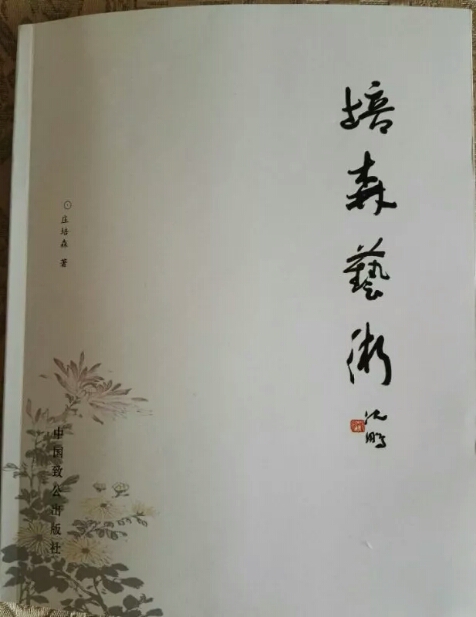
四十余年在书画道路上坚忍不拔,浸淫畅游,乐此不疲,满目硕果,终成大器。近些年分别出版了《庄培森书画选》《培森书画》《庄培森诗词书画选》《培森墨韵》等。并在北京、山东、厦门等地举行多次书画展览。沈鹏,吴祖光、董寿平、杨善深等名家前辈为著作、展览题名。在北京、厦门、山东等地建立了多个庄培森书画艺术工作室,创办培森庄苑,倡导“艺道兼培,由木而森”的教学理念。被中央电视台,《人民日报》《中国书法》《书法报》《中国书画报》等几十家媒体报导和介绍。
For more than 40 years, he has persevered in calligraphy and painting, immersed himself in it and enjoyed it. He has made great achievements. In recent years, he has published Zhuang Pei Sen's calligraphy and painting selections, Pei Sen's calligraphy and painting selections, Zhuang Pei Sen's poems, calligraphy and painting selections, and Peisen's ink rhyme. And held many calligraphy and painting exhibitions in Beijing, Shandong, Xiamen and other places. Shen Peng, Wu Zuguang, Dong Shouping, Yang Shanshen and other famous masters and predecessors named the works and exhibitions. In Beijing, Xiamen, Shandong and other places, we have established a number of Zhuang Peisen painting and calligraphy art studios, and founded Peisen Zhuangyuan, advocating the teaching concept of "cultivating both art and morality, from wood to forest". It has been reported and introduced by dozens of media such as CCTV, people's daily, Chinese calligraphy, calligraphy daily, and Chinese calligraphy and painting.
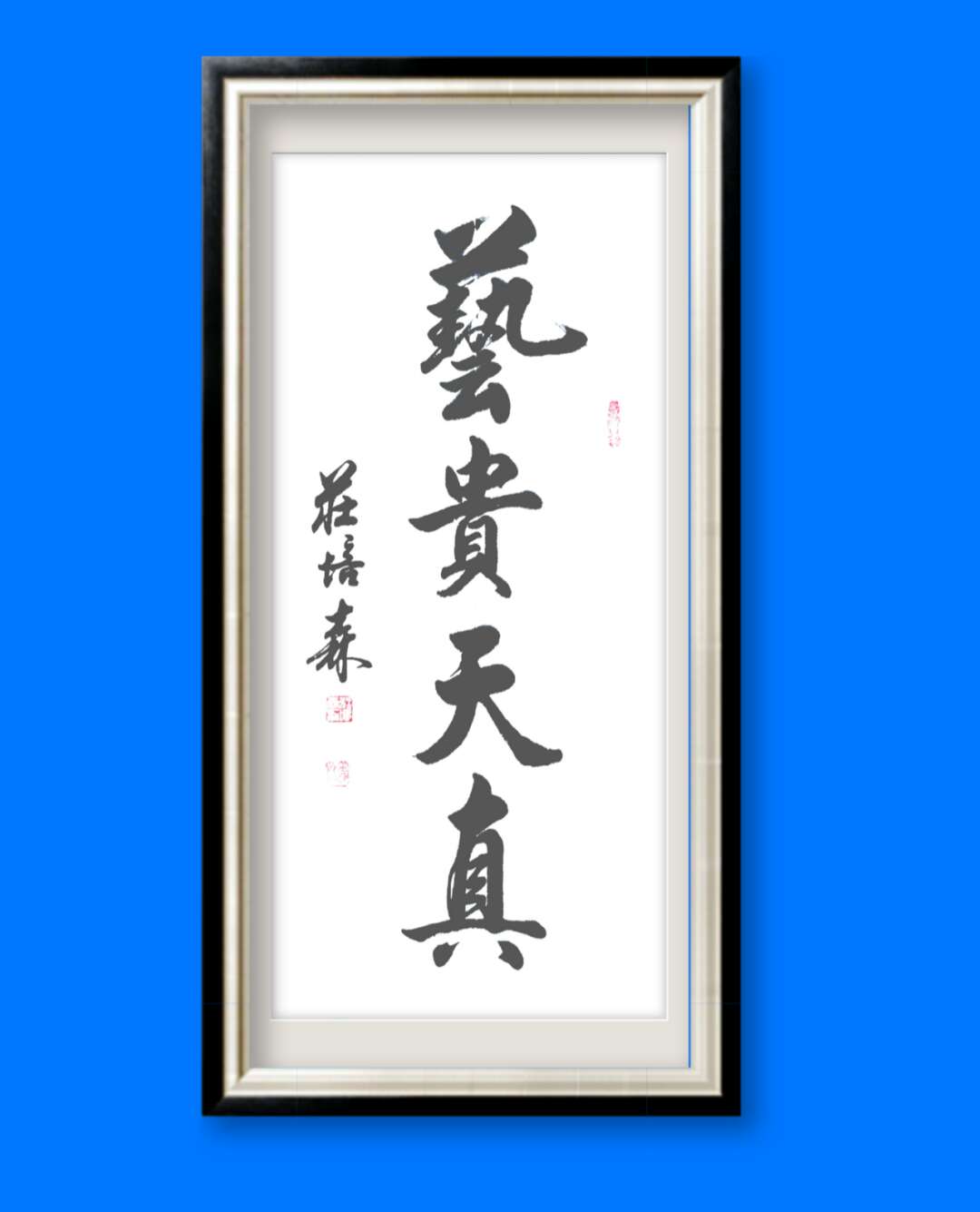
庄培森在书法、绘画、篆刻、诗词、文章等中国古典文化方面的功力,历史地把庄培森推到了引领中国书画的前沿,国内书画行业已出现了庄培森艺术理论研究者。
Zhuang Peisen's skills in calligraphy, painting, seal cutting, poetry, articles and other aspects of Chinese classical culture have historically pushed Zhuang Peisen to the forefront of Chinese painting and calligraphy, and Zhuang Peisen's art theory researchers have emerged in the domestic calligraphy and painting industry.
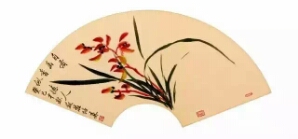
庄培森的书法绘画作品的创作理念主要是来自于阴阳互动的对立统一说。目前,庄培森正在从理论上整理他的“庄而逍遥自然为美”的对立统一理论体系。笔者有幸听到了庄培森通过对立统一的观点对他书法和绘画作品的点评。
The creative idea of Zhuang Peisen's calligraphy and painting works mainly comes from the theory of the unity of opposites between yin and Yang. At present, Zhuang Peisen is sorting out his theory system of unity of opposites that "Zhuang but carefree, nature is beauty". The author is lucky to hear Zhuang Peisen's comments on his calligraphy and paintings through the viewpoint of unity of opposites.

庄培森介绍说:从中国传统哲学来讲,世上的一切事物都起于无而生于有,即:道生一,一生二,二生三,三生万物,万物负阴而抱阳,冲气以为和。用现代哲学来讲,就是世上的一切事物都处在对立统一的矛盾之中。庄培森就是用对立统一的哲学方法来处理他在书画创作过程的各种矛盾的。
Zhuang Peisen said: from the perspective of traditional Chinese philosophy, everything in the world originates from nothing and comes from being, that is, Tao gives birth to one, life to two, two to three, and three to all things. All things are negative and hold Yang, and Chong Qi is harmonious. In modern philosophy, everything in the world is in the contradiction of unity of opposites. Zhuang Peisen used the philosophical method of unity of opposites to deal with all kinds of contradictions in the process of his calligraphy and painting creation.

▲泰山石刻庄培森的书法作品:庄而逍遥自然为美
Zhuang Peisen's calligraphy works in Taishan stone carving
庄培森举例说:书画创作的第一对矛盾就是人与书画工具的矛盾。本来一张纸,一只笔没有什么联系,可是在人的作用下,人与纸笔就产生了矛盾,书写者对笔的运用就产生了统一的关系。一张纸洁白,可视为无中生有的起点,随着第一笔落墨也就有了“有而生一”,接下来便一生二,二生三,三生万笔而互抱阴阳。最后形成了线条参差,墨色协调,统一和谐而又富于变化的书法作品。人和书画是什么矛盾呢?就是执笔和用笔的矛盾。自古而今,书画执笔无非赵孟頫于《兰亭跋》中云:“盖结字因时相传,用笔千古不易。”这是指运笔中有提、转、使、按之说。在人与笔之间人是主要的,笔是次要的。书法的对立统一就是体现在运笔时的提、转、使、按之间。
Zhuang Peisen, for example, said: the first pair of contradictions in calligraphy and painting creation is the contradiction between people and painting tools. Originally, a piece of paper and a pen have nothing to do with each other, but under the action of human beings, there is a contradiction between man and paper and pen, and the writer's use of pen has a unified relationship. A piece of white paper can be regarded as the starting point of making something out of nothing. With the first stroke of ink, there will be "one comes out of being". Then one will live two, two, three and ten thousand strokes, and embrace Yin and Yang. At last, the calligraphy works with different lines, harmonious ink color, unity, harmony and variety were formed. What is the contradiction between people and painting and calligraphy? It's the contradiction between writing and using. Since ancient times, calligraphy and painting are nothing more than Zhao Mengfu's "Lanting postscript" that "gaijie" is handed down from time to time, and it is not easy to use the pen for thousands of years This is to say that there are mention, turn, make and follow in the writing. Between man and pen, man is primary, pen is secondary. The unity of opposites of calligraphy is reflected in the movement of the brush between the lift, turn, make, press.
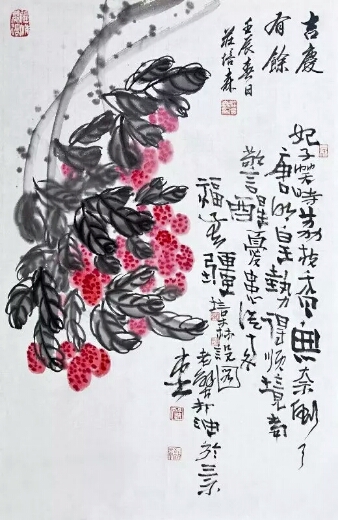
而这过程的种种微妙之感是非亲自握笔书者不能体会到的。庄先生还亲自操笔,边写边介绍了书写过程中哪里出现了对立,哪里化作了统一,作品里边都哪里出现了矛盾。他又是怎样通过笔的“提、转、使、按”,使这些矛盾得到了化解。庄先生写的是唐朝杜审言的句诗:“云霞出海曙 梅柳度江春。”起笔要压住阵脚,稳住全篇,因此用重笔重墨。而重笔重墨中又要富于变化而不成墨猪,于是在第一笔拉出牵丝,第二笔再重膀横压而形成宽肩柳臂之势。在此笔的运动过程中,先逆锋压笔,接着提笔、使笔、转笔、最后轻轻收笔,使之出现了中锋饱满,笔力沉稳由粗变细而富有弹性的效果。第三笔在横臂下边几点逶迤,如一串珍珠摇曳下来,使两侧空间疏透。
And the subtle feeling of this process can not be realized by those who do not hold the pen. While writing, Mr. Zhuang also introduced where the opposition and unification appeared in the writing process, and where there were contradictions in the works. How did he resolve these contradictions through the "mention, turn, use, press" of the pen. Mr. Zhuang wrote a poem by Du Shenyan of the Tang Dynasty: "clouds go out to sea, plum blossoms at dawn, and spring in the river." At the beginning of writing, we should hold the whole article firmly, so we should use heavy pen and heavy ink. In the heavy brush and heavy ink, there are also changes but not ink pigs. So in the first stroke, the lead wire is pulled out, and the second brush is pressed horizontally to form a wide shoulder willow arm. During the movement of the pen, first press the pen against the front, then pick up the pen, make the pen, turn the pen, and finally gently close the pen, which makes it full of center, steady and elastic. The third brush is meandering at a few points under the cross arm, like a string of pearls, which makes the space on both sides transparent.
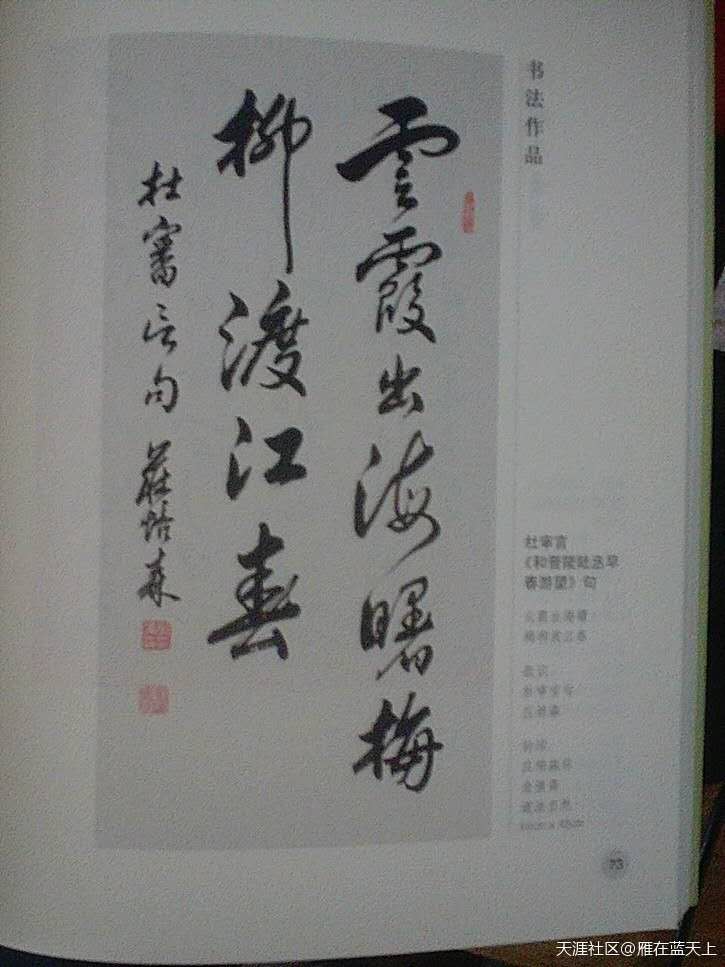
▲庄培森的书法作品:云霞出海曙,梅柳渡江春
Zhuang Peisen's calligraphy works: clouds rising from the sea, Meiliu crossing the river and spring
庄培森的书法作品写到此处,庄先生转过头来告诉我:这就是对立统一方法在一个字上的应用,当然了这些思考过程和运笔手法都是在一瞬间完成的,就像打抢一样,屏息、瞄准、扣动板机要一气呵成,不然的话就会脱节,书法上讲就会断气。
Zhuang Peisen's calligraphy works are written here. Mr. Zhuang turned his head and told me: This is the application of the method of unity of opposites in a word. Of course, these thinking processes and writing techniques are completed in an instant. Just like fighting and robbing, holding one's breath, aiming and pulling the board machine should be completed in one breath. Otherwise, it will be out of touch and the calligraphy will be out of breath.

庄先生将笔伸到砚台里舔了舔墨,又开始写了下去。他说,往下写时,就要照顾第一个字和第二个字之间的关系了,什么关系?就是第一个字的最后一笔是竖长形的,因此第二个字就得能接住下垂的笔画,不然就是漏气了,此时庄先生又从“云”字的最后一笔处帯出一细微牵丝,使之与下边的字接上了气脉,有了呼应。再接下来,庄先生便如行云流水般地一气呵成地写完了这幅作品。
Mr. Zhuang put his pen into the inkstone, licked the ink and began to write again. He said that when writing down, we should take care of the relationship between the first word and the second word. What is the relationship? That is, the last stroke of the first character is vertical and long, so the second character must be able to catch the drooping strokes, or there will be air leakage. At this time, Mr. Zhuang took a small lead wire from the last stroke of the "cloud" character to connect it with the character below, and it had a echo. Next, Mr. Zhuang finished the work in one breath like flowing water.
接着给我讲起了这幅作品的对立在哪,统一在哪,最后的效果是和谐美妙在哪。总体来讲,写书法首先要考虑整篇的效果,整篇效果可用四个字来把握即“起,承、转、合、”。这里其实就是构图和布局。而当写每个字时则要注意“提、转、使、按”。庄先生认为这八个字就是对立统一方法在书法上的具体运用。
Then he told me where the opposition of this work is, where the unity is, and where the final effect is harmony and beauty. Generally speaking, writing calligraphy should first consider the effect of the whole article. The whole effect can be grasped by four words, that is, "starting, inheriting, transferring, combining.". This is actually the composition and layout. When writing each word, we should pay attention to "lift, turn, make, press". Mr. Zhuang believes that these eight characters are the concrete application of the method of unity of opposites in calligraphy.
庄先生讲,书法和音乐不同,一般情况下,书法的首笔首字都重笔压阵。而音乐则多是弱拍起,甚至有时是弱到天外来音。第一个字按此规律书写,第二个字就具有承上启下的作用了,像这个“霞”字,上能承接云字,下能引领“出”字,“霞”大则“出”小,形成了对立统一,使作品出现了第二次对立,第一次是出现在“云”和“霞”字的弱实对立。至此,本作品的第一个小高潮结束。在这个节奏里边,每个字的点划搭配,线条的粗细变化,其实都是一种对立和统一的关系,也就是变化和呼应的关系。
Mr. Zhuang said that calligraphy is different from music. In general, the first characters of calligraphy are stressed. And music is mostly weak beat, and sometimes even weak to the outside of the sky. When the first character is written according to this law, the second character has the function of connecting the preceding and the following. For example, the character of "Xia" can inherit the character of cloud at the top and lead the word "out" at the bottom. The word "Xia" forms the unity of opposites, which makes the work appear the second opposition. The first is the weak real opposition between "cloud" and "Xia". At this point, the first climax of this work is over. In this rhythm, the punctuation and collocation of each word and the change of line thickness are actually a relationship of opposition and unity, that is, the relationship between change and echo.
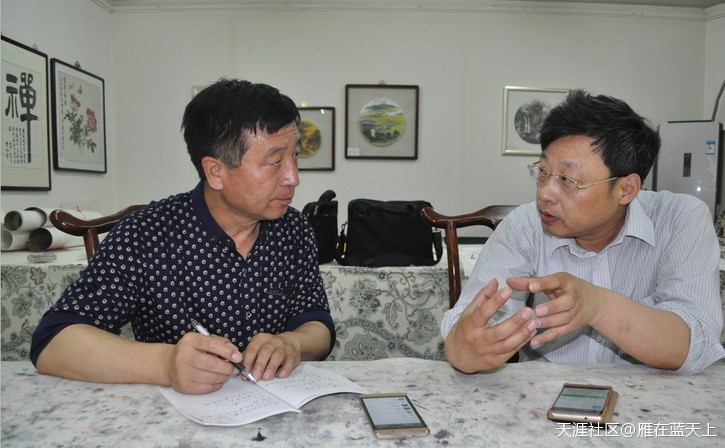
▲庄培森向笔者讲解“庄而逍遥自然为美”所包含的对立统一关系
Zhuang Peisen explained to the author the unity of opposites contained in "Zhuang and carefree nature is beauty"
韩美林曾说过:我学到了唯物主义归纳起来两个字------实际。我学到的辩证法归纳起来两个字----对比。总而言之一个字-----易。周易二字不言自解,周是周而复始,易是相互转化,起点就是终点。不管是圆的或是直的。
Han Meilin once said: I learned materialism, summed up in two words - reality. The dialectics I learned can be summed up in two words - contrast. In a word, easy. The two words of Zhouyi are self explanatory. Zhou is the beginning of the cycle, and the change is mutual transformation. The starting point is the end point. Whether it's round or straight.
庄培森认真地分析了韩美林的38米长卷的巨幅草书《般若波罗密多心经》:起首“般”字重笔浓墨,使全篇稳住,接着“若“字便细线象丝,给“般”字留出了对比空间。下边的“波”字再度加粗加重,承住了上边两个字的压力,第二行的“罗”字又瘦锋起笔,墨带飞白使之与相邻的“般”字形成了浓淡、大小、粗细的巨大变化,一下子便抓住了读者的眼球,让你顺着这笔势往下看去。接着作者的挥毫用墨便如惊涛拍岸,狂风入林,重墨处如高山落石有万钧之力,细弱处像牛毛细雨似断还连。一路挥洒,一路腾挪,一丝留白,一滩重墨。于是便出现了聚集浓淡、疏密、粗细、长短、曲直、强弱、攲正等无处没有对立效果的38米狂草作品。这样的作品,看一次受一次冲击,看一次有一次感受,这就是对立统一方法给书法带来的魅力。
Zhuang Peisen has carefully analyzed Han Meilin's huge manuscript Prajna paramita's Heart Sutra, which is 38 meters long. At first, the word "ban" is thick and thick, which makes the whole article stable. Then, the word "Ruo" will be thin as silk, leaving room for comparison with "ban". The word "Bo" at the bottom is thicker and heavier again, which bears the pressure of the two characters above. The word "Luo" in the second line starts writing thin and sharp again. The ink band is flying white, which makes it form a huge change in the thickness, size and thickness of the adjacent "ban" characters. All of a sudden, it catches the reader's attention and lets you look down along the stroke. Then the author's use of ink will be like a storm rippling on the shore, the wind into the forest, heavy ink like mountains falling rocks, with the force of thousands of Jun, weak parts like cattle capillary rain like broken. All the way, all the way, a trace of white, a pool of heavy ink. Therefore, there appeared 38 meter wild grass works with no opposite effect, such as concentration, density, thickness, length, straightness, strength and rightness. This is the charm of the unity of opposites method to calligraphy.
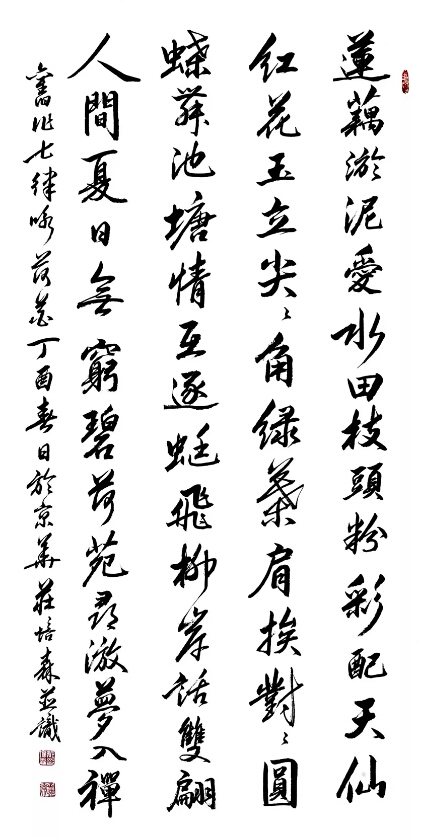
庄先生告诉我,可能是有家族遗传的影响,也可能是受古人思想的启迪,也更可能是与当代大师们交流受到了鼓励,他要把他发现的“庄而逍遥、(阴阳相对、日精月华、)自然为美”的理念系统地整理出来。在人们越来越远离手书的电脑时代,让人们能更快地掌握书法的规律,使书法这一传统文化的艺术瑰宝得以发扬光大。
Mr. Zhuang told me that it may be due to the influence of family heredity, the Enlightenment of the ancient thought, and the encouragement of communication with contemporary masters. He wants to systematize the idea that "Zhuang is carefree, yin and yang are opposite, the essence of the sun and the moon is beauty.". In the computer age when people are more and more far away from handwritten calligraphy, people can master the law of calligraphy more quickly and carry forward the art treasure of calligraphy as a traditional culture.
让庄先生欣慰的是,当代书法大家刘艺先生了解到庄培森的想法后,在《培森书画》首发式上讲到:“我一辈子想找的理念,现在由你帮我总结出来了,我愿后半生与你一同去完善,践行这一理念。”
What gratifies Mr. Zhuang is that Mr. Liu Yi, a contemporary calligrapher, said at the opening ceremony of Pearson's calligraphy and painting: "the idea I've been looking for all my life is summed up by you. I'd like to work with you in the rest of my life to improve and practice this idea."

▲庄培森《戏虾图》
The painting of prawns by Zhuang Peisen
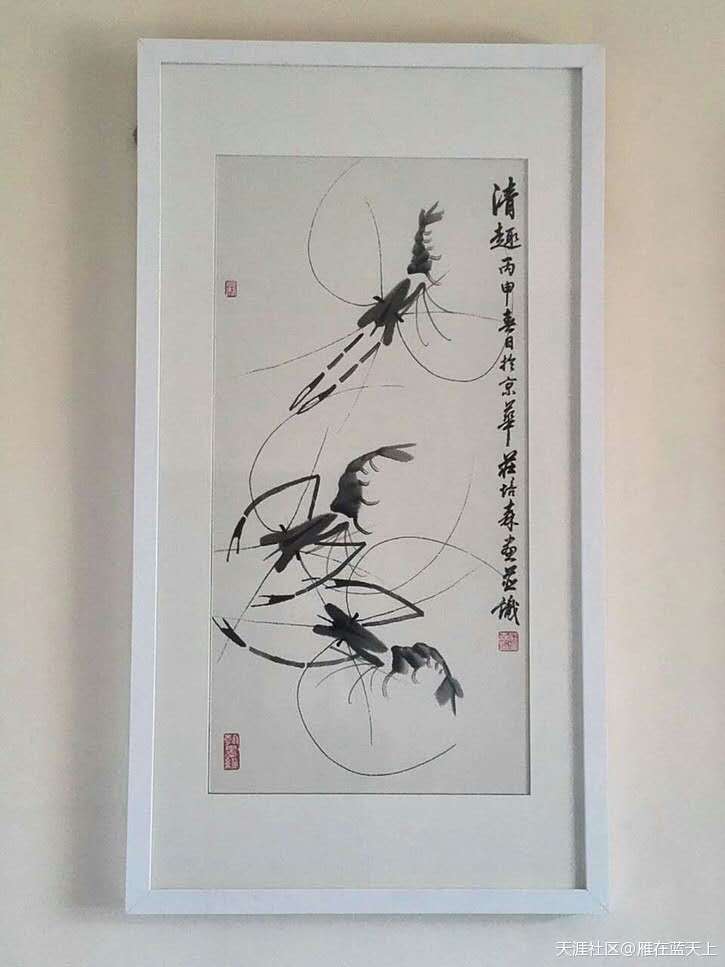
▲庄培森《清趣》
Qingqu by Zhuang Peisen
郝连成 于2016年5月采写于北京
Hao Liancheng wrote in Beijing in May 2016


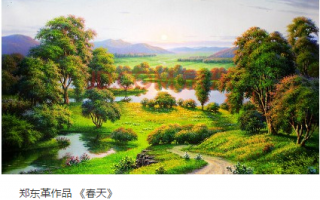


雁在蓝天